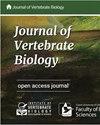Environmental determinants of minimum body temperature in mammals
IF 1.5
4区 生物学
Q2 ZOOLOGY
引用次数: 7
Abstract
Abstract. Physiological regulation of body temperature, set at a high level, is one of the key features of endothermic homeotherms, such as birds and mammals. However, many mammals and some birds have evolved the ability for temporal down-regulation of core body temperature. We investigated how variation in environment temperature and habitat primary productivity determine variation in daily body temperature down-regulation among mammalian species. Nearly half of the variation in minimum daily body temperature among species was explained by variation in both primary productivity and environmental temperature. Mammals expressing low minimum body temperature inhabited regions of low annual temperature with wide daily and seasonal temperature variation. Simultaneously, those regions were characterized by low productivity and low seasonality in productivity. Furthermore, regions characterized by a high level of among-year variation in environmental temperature, but not in primary productivity, were inhabited by species with low minimum body temperature, but only by those adapted to relatively humid conditions. Our results suggest that daily heterothermy can be selectively advantageous in the environmental circumstances when high energetic demands for maintaining endothermic homeothermy, physiological regulation of a high and stable body temperature, cannot be supported. The results corroborate the hypothesis that mammals that have evolved daily down-regulation of body temperature may have higher chances of surviving extinction events caused by climatic changes. Therefore, daily heterothermy adaptation in contemporary mammals represents a mechanism for surviving the ongoing global warming.哺乳动物最低体温的环境决定因素
摘要体温的生理调节,设定在高水平,是吸热顺势疗法的关键特征之一,如鸟类和哺乳动物。然而,许多哺乳动物和一些鸟类已经进化出了在时间上下调核心体温的能力。我们研究了环境温度和栖息地初级生产力的变化如何决定哺乳动物物种日常体温下调的变化。物种间每日最低体温的变化有近一半是由初级生产力和环境温度的变化解释的。最低体温较低的哺乳动物生活在年温度较低的地区,日温度和季节温度变化较大。同时,这些区域的特点是生产率低,生产率季节性低。此外,环境温度年间变化很大,但初级生产力没有变化的地区,居住着最低体温较低的物种,但只有那些适应相对潮湿条件的物种。我们的研究结果表明,在无法支持维持吸热恒温的高能量需求(即高稳定体温的生理调节)的环境下,每天的恒温可能是有选择性的有利条件。研究结果证实了这样一种假设,即每天体温都在下降的哺乳动物可能更有可能在气候变化导致的灭绝事件中幸存下来。因此,当代哺乳动物每天的异养适应是在持续的全球变暖中生存的一种机制。
本文章由计算机程序翻译,如有差异,请以英文原文为准。
求助全文
约1分钟内获得全文
求助全文

 求助内容:
求助内容: 应助结果提醒方式:
应助结果提醒方式:


